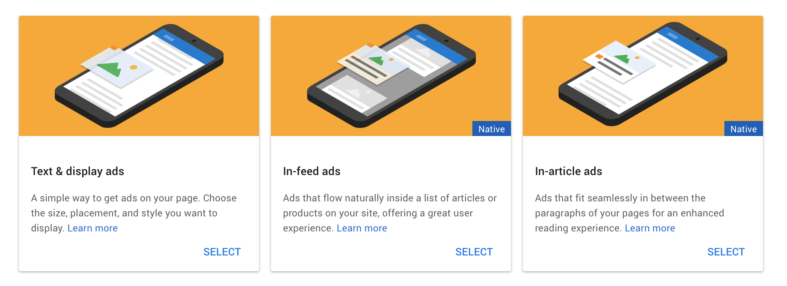You don’t have to be a publisher to leverage your website or blog to run paid advertisements on your website. AdSense. Millions of businesses, just like yours, keep generating healthy monthly revenues by leveraging their existing web and blog content. That’s right! As a publisher, you can monetize your website or blog by using Google AdSense.
Read on to learn how you can use Google’s risk-free platform to earn supplemental income.
What is Google AdSense?
Launched in 2003, Google AdSense is an automated CPC (cost-per-click) advertising platform that allows publishers to monetize their blog traffic by publishing advertiser’s relevant banner and text ads on their website blog or pages. Publishers refer to an integral segment in the Google Ad Network Ecosystem, which also consists of Users and Advertisers.
According to Google, a healthy ecosystem means that all three users find value in their relationship with Google:
- Users feel respected and protected, and continue to return to publisher sites with valuable content
- Advertisers find ROI in their investments in online advertising, with their ads shown alongside content that reflects well upon their brand
- Publishers earn ad revenue from relevant ads without distracting from their content
Google administers, sorts, and maintains these text and banner ads. Furthermore, Google can help advertisers generate revenue on either a per-click or per-impression basis. The publishers then receive a small commission every time a user clicks on one of these ads.
Why Should Publishers use Google AdSense?
If your website has sufficient monthly readership, incorporating Google AdSense into your online strategy can generate a steady revenue stream from your existing content. Aside from monetizing your content, Google AdSense yields several other benefits:
- Google AdSense is free to sign up
- An automated advertising process that can save you time
- You can run video ads by integrating your AdSense account into Google Blogger and YouTube pages
- Delivers a high level of security, safety, and transparency for both advertisers and publishers
- With over 10 million websites using the platform, Google AdSense has broad eligibility requirements
- Run ads on mobile devices and RSS feeds as well as several websites with one AdSense account
- Automatically aligning businesses that are a strong match for your (publishing) niche and audience
What Types of Ads Appear on Google AdSense?
Through Google AdSense, advertisers with similar products or services will pay for prime real estate on your website.
 Google offers a variety of ad types to run on your website, including:
Google offers a variety of ad types to run on your website, including:
- Text: Text ads use words, either as an Ad Unit (one offer) or a Link Unit (list of offers). You can customize the color of the box, text, size, and link.
- Images: Graphic ads that come in a variety of sizes. You can choose an ad feed option that mixes both text and image ads.
- Rich Media: Interactive ads that include HTML, video, and flash.
- Video: overlay video ads that display AdSense text, and display ads over the video content.
- AdSense for Search: Add a Google search box on your website or blog. When a user enters a term and conducts a search, a search results page opens with AdSense ads.
How to Create a Google AdSense Account
Google AdSense lets its advertisers compete for a coveted spot on your website based on your content. The advertisers who create the ads will bid in a real-time auction to win a spot in a publisher’s ad space. The highest bidder’s ads will appear on the website. Using its proprietary algorithms, Google will start displaying targeted ads on your page. Thus, these ads will relate to your page’s content or a user’s previous search queries.
First, you must apply to become an AdSense partner. Google will then approve your request and confirm you meet certain guidelines and metrics. Since Google receives thousands of applications each day, it may take several weeks for Google to approve your application.
Once approved, you must copy snippets of HTML code from your AdSense dashboard onto specific web pages. Next, publishers will need to generate two types of codes for Google AdSense to correctly work:
- Head code: This is a site-wide placement that monitors the website to collect details such as page type, availability of ad tags, and more
- Ad tags: These customized snippets of code can vary for different webpages
Finally, installing these codes will enable the publisher to choose the types of ads to run, and where on the page these ads will appear.
Best Google AdSense Practices for Higher ROI
- Use High-Converting Keywords: Effective keywords are the foundation of Google AdSense earnings. So use the Google Keyword Planner to create a well-rounded keyword list to target.
- Create Daily Content: Aim to publish a new blog to your website every day. As a result, you’ll increase the chance a user will click on your ad. Furthermore, Google AdSense places ads on your website based on your content’s focus. So if you want ads that are appropriate to your audience, you’ll need to create well-targeted content.
- Remember Colors and Imagery: Make sure that the border colors, background colors, link colors, and text colors all align with your website and brand identity.
- Avoid Using Too Many Ads: You can go overboard with your ads. Too many ads may overwhelm a visitor while fewer ads may not capture sufficient ad clicks you want to generate. Therefore, you’ll want to find a healthy balance with two ads per page.
- Experiment with Ads: Various components of your ad – like the image or copy – may discourage viewers from clicking through. Consider using a form of A/B testing with your ads to gauge their effectiveness.
- Consider Ad Placements: Various ad placements will ultimately yield different results. Displaying ads in priority areas can increase the likelihood that users will interact with them.
Making Sense of Google AdSense
Long-term success with Google AdSense requires writing quality SEO content that will draw in more visitors over time. More specifically, you’ll have an easier time generating more revenue if you already have ample content to work with. Thus, having an organized weekly and monthly content calendar is a great way to stay ahead of the curve.
So if you focus on keeping your site updated with new content, you should expect to see your AdSense revenue trend upward. Need help registering for Google AdSense? Give our digital marketing experts a call today by dialing (973) 346-8100.

